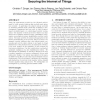Free Online Productivity Tools
i2Speak
i2Symbol
i2OCR
iTex2Img
iWeb2Print
iWeb2Shot
i2Type
iPdf2Split
iPdf2Merge
i2Bopomofo
i2Arabic
i2Style
i2Image
i2PDF
iLatex2Rtf
Sci2ools
NSPW
2015
ACM
2015
ACM
Exploiting the Physical Environment for Securing the Internet of Things
Using the randomness provided by the physical environment to build security solutions has received much attention recently. In particular, the shared entropy provided by measuring ambient audio, luminosity modalities or electromagnetic emanations has been used to build locationbased, proximity-based, or context-based security mechanisms. The majority of those protocols is based on a standard model consisting channel probing, quantization, information reconciliation, privacy amplification, and key verification. The main problem for almost all approaches is the limited understanding of the security that is provided. For example, security analyses often only address single components and not the entire system or are based on broad ions of the physical source of randomness. Further, a big open question is the feasibility of such systems for low-resource platforms. Our first contribution is a detailed, optimized realization of a key establishment system. We demonstrate the feasibility o...
| Added | 15 Apr 2016 |
| Updated | 15 Apr 2016 |
| Type | Journal |
| Year | 2015 |
| Where | NSPW |
| Authors | Christian T. Zenger, Jan Zimmer, Mario Pietersz, Jan-Felix Posielek, Christof Paar |
Comments (0)

